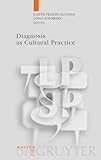Diagnosis as Cultural Practice / ed. by Judith Felson Duchan, Dana Kovarsky.
Material type: TextSeries: Language, Power and Social Process [LPSP] ; 16Publisher: Berlin ; Boston : De Gruyter Mouton, [2009]Copyright date: ©2005Description: 1 online resource (307 p.)Content type:
TextSeries: Language, Power and Social Process [LPSP] ; 16Publisher: Berlin ; Boston : De Gruyter Mouton, [2009]Copyright date: ©2005Description: 1 online resource (307 p.)Content type: - 9783110184662
- 9783110199802
- 616.07/5 22
- RC71 .D522 2005eb
- online - DeGruyter
- Issued also in print.
| Item type | Current library | Call number | URL | Status | Notes | Barcode | |
|---|---|---|---|---|---|---|---|
 eBook
eBook
|
Biblioteca "Angelicum" Pont. Univ. S.Tommaso d'Aquino Nuvola online | online - DeGruyter (Browse shelf(Opens below)) | Online access | Not for loan (Accesso limitato) | Accesso per gli utenti autorizzati / Access for authorized users | (dgr)9783110199802 |
Frontmatter -- Contents -- Contributing authors -- Chapter 1. Introduction -- Chapter 2. Diagnosis as an aid and a curse in dealing with others -- Chapter 3. A diagnosed life in an institutional setting: Can the dancer walk? -- Chapter 4. From diagnostic to aesthetic: Moving beyond diagnosis -- Chapter 5. Revisiting authority in physician-patient interaction -- Chapter 6. "I just wanna know why": Patients' attempts and physicians' respronses to premature solicitation of diagnostic information -- Chapter 7. Aggravated resistance to problem formulations in therapy -- Chapter 8. Learning to diagnose: Production of diagnostic hypotheses in problem-based learning tutorials -- Chapter 9. Emotion and objectivity in medical diagnosis -- Chapter 10. The diagnostic practises of Speech-Language Pathologists in America over the last century -- Chapter 11. The diagnosis of deafness in Nicaragua -- Chapter 12. Documenting awareness of the cultural process of diagnosis: Letters of recommendation for medical school faculty -- Chapter 13. Speaking about menopause: Possibilities for a cultural discourse analysis -- Chapter 14. The diagnosis of the constituents of communication in everyday discourse: Some functions, enabling conditions, consequences, and remedies -- Backmatter
restricted access online access with authorization star
http://purl.org/coar/access_right/c_16ec
This book is about the doing and experiencing of diagnosis in everyday life. Diagnoses are revealed as interactive negotiations rather than as the assigning of diagnostic labels. The authors demonstrate, through detailed discourse analyses, how the diagnostic process depends on power and accountability as expressed through the talk of those engaged in the diagnostic process. The authors also show that diagnostic decisions are not only made by professional experts trained in the art and science of diagnosis, but they can also be made by anyone trying to figure out the nature of everyday problems. Finally, diagnostic reasoning is found to extend beyond typical diagnostic situations, occurring in unexpected places such as written letters of recommendation and talk about the nature of communication. Together, the chapters in this book demonstrate how diagnosis is a communication practice deeply rooted in our culture. The book is interdisciplinary and unusually broad in its focus. The authors come from different experiential scholarly backgrounds. Each of them takes a different look at the impact and nature of the diagnostic process. The diagnoses discussed include autism, Alzheimer’s disease, speech and language disorders, and menopause. The focus is not only on the here and now of the diagnostic interaction, but also on how diagnoses and diagnostic processes change over time. The book can serve as an undergraduate or graduate text for courses offered in various disciplines, including communication, sociology, anthropology, communication disorders, audiology, linguistics, medicine, and disability studies.
Issued also in print.
Mode of access: Internet via World Wide Web.
In English.
Description based on online resource; title from PDF title page (publisher's Web site, viewed 28. Feb 2023)


